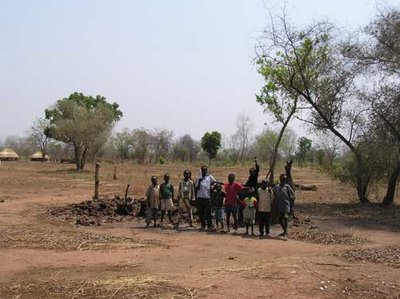I had stayed in Lui on Friday and Saturday, when some of our group went out to visit and work in the outlying villages. Monday it was my turn to join in one of those trips.
We left Lui at 7:50 a.m. and arrived at about 10:20 a.m. – 2½ hours to make a journey of less than 50 miles – again, an indication of how bad the roads are.
Here again, I had the amazing experience of their radical, welcoming hospitality. We had been in the truck for a long time and – I don’t know about others – but I was feeling pretty miserable as my butt was slammed time and again over the ruts, and experiencing the considerable heat, and the overcrowding in the truck.
But then we arrived in the village to the sound of their songs and the sight of those warm, welcome smiles.
This is one of the villages that was attacked by the Dinka last fall. The village was burned in September by the Dinka, and 17 people were killed. I don’t really have a sense of the village’s total population, but it sure seemed small – so small that 17 deaths would be huge by any calculation.
Some of the mud structures partially withstood the burning.

 But the grass structures burned all the way to the ground.
But the grass structures burned all the way to the ground.What I did not realize immediately was that it wasn’t just a structure that was lost in those fires. Each burned-out family lost everything -- their few clothes, all their cooking utensils, all their farming implements. In addition – and more importantly – many of them lost family members. When attackers come – whether from the Khartoum army or the Dinka rebels – anyone who is not fast enough to disappear into the bush is probably going to be murdered – hacked to death by machetes. It’s just too horrible to contemplate for very long.
Deborah said that when she was getting acquainted in Lui, one of the questions she would ask people is, “What does the peace mean to you?” One of the common replies was, “Being able to build with mud – not just grass.” I think there are two dimensions to that reply. First, building with mud and brick is much more labor-intensive than building from grass bundles. Thus, one has to make more of an investment to build from mud. But then I understood there’s a second dimension. When you build and live in a grass hut, it means you can escape anywhere, as long as you can push through the grass – whereas mud huts only have one or two exits. So feeling safe enough to build with mud means you feel you don’t need so many exits. Kyrie eleison.
Among the structures burned was the school. Archdeacon Robert went venturing across the road to where the school had been, and snapped this photo.

The kids are still there! – waiting and hoping for the school to re-open!




No comments:
Post a Comment